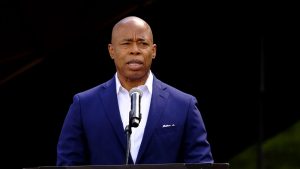
Source: nypost.com
Due to its complicated ranked-choice voting, combined with the mishandling of test vote records, New York’s Democratic Mayoral Primary will drag on for weeks through the sweltering heat of the New York summer. And while Curtis Sliwa scored a decisive victory over rival Fernando Mateo (71.8% to 28.2%), the Democratic primary winner will not be known for weeks, leaving the Big Apple residents in a political fog, even as their city is torn by racial strife and violent crime. Currently, Eric Adams holds a slight lead (51.1%) over his closest Democratic rival, Kathryn Garcia (48.9%).
What is Ranked-Choice Voting (RCV)?
The delayed results stem partly from ranked-choice voting (RCV). According to Ballotpedia:
…RCV is an electoral system in which voters rank candidates by preference on their ballots. If a candidate wins a majority of first-preference votes, he or she is declared the winner. If no candidate wins a majority of first-preference votes, the candidate with the fewest first-preference votes is eliminated. First-preference votes cast for the failed candidate are eliminated, lifting the second-preference choices indicated on those ballots. A new tally is conducted to determine whether any candidate has won a majority of the adjusted votes. The process is repeated until a candidate wins an outright majority.
RCV came into existence to combat the long-standing problems of low-voter turnout, uncivil campaigning, and the seemingly undemocratic nature of traditional election structures. As Columbia News reports, “New York City has been suffering, like the rest of the country, from low turnout at elections, negative campaigning, and candidates winning by pluralities that represent small percentages of the electorate. Ranked-choice voting was implemented to improve the representativeness of the voting system.”
Despite its apparent complexity, one of the biggest advantages of RCV is that it eliminates run offs. This is important because voter participation tends to decrease significantly in run-off elections. The National Conference of State Legislators reports that “ [r]research from Professor Charles Bullock III from the University of Georgia found that runoffs attract 20 to 30 percent fewer voters in many states.”
And because RCV is an evolving dynamic with multiple choices for voters, candidates are encouraged to soften their ideological stances and appeal to a wider swath of the electorate, simply because they may need the second- or third-choice status of voters. As Fair Vote California puts it: “By courting second and third choice votes, candidates have the opportunity and incentive to connect with a wider span of voters.”
And even though Adams met the threshold of 50% + votes, a voting snafu has thrown the proverbial monkey wrench into the system. CNN reported “within hours of the new figures coming online, the [New York Voting] board backtracked — following questions from the Adams campaign and others — and acknowledged a ‘discrepancy’ in its counting process. It subsequently removed the data from its website.”

To make matters worse and bring into question the integrity of the whole voting apparatus, the board then mistakenly included “135,000 test votes in their election data reporting system used to relay results to the public” Yahoo News reported. In a city mired in a history of election fraud and malfeasance, this is the last thing beleaguered New York voters needed. As an article by Business Insider points out: “This also marks the latest inflection point in decades of incompetence and dysfunction for the troubled New York City Board of Elections, which has struggled with administering elections and maintaining voter rolls in the recent past.”
Is RCV Better Than Traditional Voting?
This calls into question whether RCV is any better, if not worse, than traditional voting systems. An Op-Ed by the American Enterprise Institute states “…the test ballot ‘results’ made clear, this is a system that, as it stands, can introduce serious distortions. Kathryn Garcia’s open strategy to gain second place votes — which would become first place votes once Andrew Yang or others were eliminated — raises the possibility that the ultimate winner could have more runner-up than first place votes. Do we really want a Mayor who the largest number of voters think is second-best?” Good question.
Interestingly, both Adams and Garcia represent more mainstream, centrist perspectives than many of the other candidates, some of which called for the controversial defunding of police, such as Democrat Maya Wiley, who to her credit, garnered nearly 20% of the vote by June 30. This undercuts the idea that African Americans as a whole share radical political perspectives that some of their more progressive White counterparts endorse. As Gil Troy, Professor of History at McGill University writes in Politico, “Today, African-Americans vote Democratic overwhelmingly but are more traditional, less libertine, than most white liberals, among other deviations from PC doctrine.”
So, who are the remaining Democratic candidates, and what can they offer New Yorkers?
Eric Adams’s plan for New York has four components:
- A Smarter City–improving city government efficiency and effectiveness
- A Safer City–Improving public health and safety
- A Fairer City–a more inclusive economy and affordable housing options
- A City of the Future–improving infrastructure and environmental conditions
Adams served as an officer in the New York City Transit Police and then the New York City Police Department for over two decades, retiring with the rank of captain. He was also a member of the New York State Senate from 2006 to 2013 (20th Senate district in Brooklyn), and served as Brooklyn Borough President, the first African American to hold the position, and was reelected in November 2017.
Adams does, however, have a bit of a populist appeal, branding himself as “the people’s candidate.” With one foot in the arena of the drive-for-equity movement, and the other foot solidly planted in the gritty, urban reality of NY politics, Adams represents a progressive view tempered by practical experience. Addressing New York City’s conflicting issues of crime and police brutality and misconduct, Adams recently stated, ““The uniqueness of my experience will allow me to ensure we could have both those entities.”
Katheryn Garcia is also a veteran of the New York political machine. She served as commissioner for the New York City Sanitation Department from 2014 to 2020, and as an interim chair and CEO of the New York City Housing Authority, was appointed “food czar” for New York’s emergency food program during the COVID-19 emergency response. According to Wikipedia: “In her first month as food czar, she coordinated a massive effort to distribute free meals at more than 400 schools, and a home delivery program that hired 11,000 taxi drivers to provide 120,000 to 140,000 meals per day to seniors, COVID-vulnerable, and homebound New Yorkers. The program cost the city $170 million and distributed 130 million meals during Garcia’s tenure.”
Garcia has been endorsed by both the New York Times Editorial Board and The New York Daily News, casting her as an establishment candidate. Much like Adams, she is looking to strike a balance with regard to combating crime while also addressing issues with police brutality. To that end, her website states that “Driving down crime and police reform are not in conflict with one another. When we measure the right metrics we can keep our communities safe and reform the NYPD.”
Garcia would be the firt woman to serve as mayor of New York city, no small feat. But while Garcia’s campaign focus is a bit more expansive than Adams, tackling issues such as climate change and education reform, these candidates are probably more alike than different. And after eight years of Mayor Deblasio’s ideologically-driven tenure, New Yorkers seem to want more practical approaches to the many problems plaguing the city that never sleeps.
At Newsweed.com, we adhere to three simple principles: truth, balance, and relatability. Our articles, podcasts, and videos strive to present content in an accurate, fair, yet compelling and timely manner. We avoid pushing personal or ideological agendas because our only agenda is creating quality content for our audience, whom we are here to serve. That is why our motto is ”Rolling with the times, straining for the truth.”
Your opinion matters. Please share your thoughts in our survey so that Newsweed can better serve you.
Charles Bukowski, the Los Angeles beat poet that captured the depravity of American urban life once said, “There is something about writing poetry that brings a man close to the cliff’s edge.” Newsweed is proud to stand in solidarity and offer you a chance to get close to the cliff’s edge with our first Power of Poetry Contest. Are you a budding bard, a versatile versifier, a rhyming regaler? Do you march to the beat of iambic pentameter, or flow like a river with free verse? If so, here’s your opportunity to put your mad poetic chops to the test. Enter our poetry contest for bragging rights and an opportunity to win some cash!

